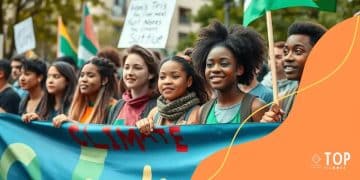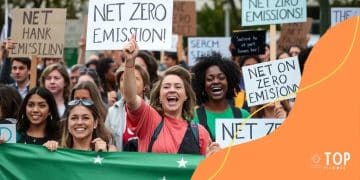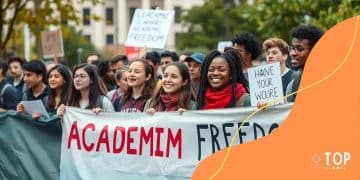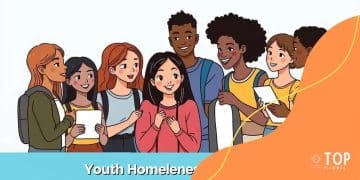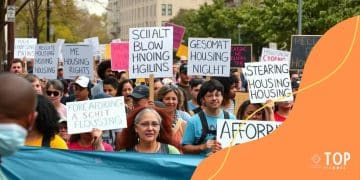Student protest movements: shaping the future now

Student protest movements play a vital role in advocating for change on critical issues such as gun control, climate action, and social justice, demonstrating the power of youth activism in influencing policy and public opinion.
Student protest movements have historically stood at the forefront of social change. These gatherings of passionate individuals often reveal the power of youth in advocating for justice and equality. What drives these movements, and how do they impact our society?
Understanding the history of student protest movements
The history of student protest movements is rich and varied, showcasing the influence young people can have on societal changes. From the civil rights movement to today’s climate change actions, students have always found their voice. Understanding this history is crucial for recognizing how these protests shape our world.
Key Historical Events
Throughout the decades, several monumental protests have defined the landscape of student activism. For example, the protests during the 1960s for civil rights and against the Vietnam War brought together diverse groups of students. These events marked a turning point that showed how powerful collective action can be.
- The 1964 Free Speech Movement at UC Berkeley.
- The anti-Vietnam War protests of the late 1960s.
- The Kent State shootings in 1970, which reignited protests across campuses.
- The recent demonstrations for climate action initiated by young activists worldwide.
These events have not only influenced educational institutions but have also contributed to broader societal changes. The passion exhibited during such times often highlights issues like inequality, war, and environmental concerns, resonating with the public and prompting action.
Impact on Society
The impact of student protests is profound. By organizing and voicing their opinions, students have affected legislation and altered public perception on critical issues. For instance, the protests of the 1980s against apartheid saw a surge in global awareness and support for the anti-apartheid movement.
Through history, students have demonstrated their ability to mobilize support and stand against injustice. Their activism often goes beyond individual campuses, becoming a part of larger movements that strive for change. Such movements inspire future generations and prove that the voice of youth can lead to significant shifts in societal norms.
Key issues that ignite student protests
Many factors prompt students to organize protests. Understanding these key issues gives insight into their motivations and concerns. Some topics resonate strongly with students, leading them to take action and advocate for change.
Social Justice and Equality
One of the most significant issues that ignite student protests is the demand for social justice and equality. Students often rally against discrimination based on race, gender, or sexual orientation. Historical movements, like those for civil rights, inspire ongoing activism.
- Racial discrimination and police violence.
- Gender inequality in education and employment.
- Support for LGBTQ+ rights and protections.
These matters not only affect students personally but also reflect the larger societal inequalities. As future leaders, students feel compelled to push for justice and equality for all.
Environmental Concerns
Another pressing issue is the environment. Climate change has become a pivotal topic that fuels protest. Many students express frustration with the lack of action from political leaders. Inspired by activists like Greta Thunberg, students gather to demand urgent measures to protect our planet.
Environmental activism includes various tactics, such as:
- Demanding sustainability practices on campuses.
- Advocating for policies that reduce carbon emissions.
- Supporting renewable energy initiatives.
This sense of responsibility to care for the environment drives students to unite and seek change.
Education and Debt
Students often protest for fair education policies. Issues like rising tuition costs and student debt impact many young people. They advocate for accessible education without the burden of crippling loans.
Students frequently raise awareness about:
- Student debt cancellation initiatives.
- Affordability of college tuition.
- Equity in funding for public schools.
These arguments highlight their desire for a more equitable educational system that allows everyone to learn without financial strain.
The role of social media in mobilization

The explosion of social media has transformed how student protest movements mobilize and organize. In today’s digital age, platforms like Twitter, Instagram, and Facebook play crucial roles in connecting students and spreading awareness about important causes.
Instant Communication
One of the key benefits of social media is its ability to facilitate instant communication. Students can share information swiftly, helping to coordinate protests and rallies efficiently. For example, a single tweet can inspire thousands to join a movement in a matter of hours.
- Real-time updates on events and location changes.
- Easy sharing of important resources, such as flyers and links.
- Encouraging others to participate through personal stories.
This speed allows student activists to respond immediately to events or injustices as they unfold, amplifying their message effectively.
Building Community
Social media also fosters a sense of community among like-minded individuals. Students who might feel isolated in their activism can find others who share their values and commitments. Online forums and groups provide a space to discuss ideas and strategies, making activism feel more accessible.
Through these connections, students can:
- Create networks that span across cities and countries.
- Share success stories that motivate others.
- Collaborate on campaigns and initiatives.
These communities often lead to stronger movements, as individuals feel supported and empowered to contribute.
Raising Awareness
Moreover, social media is an incredible tool for raising awareness. Students can share photos, videos, and stories that highlight the reasons behind their protests. This visual content captures attention and can go viral, reaching a wider audience than traditional media.
For instance, trending hashtags can promote campaigns, leading to increased visibility for the issues at hand. This not only educates the public but also puts pressure on decision-makers to respond to student demands.
Impact of student protests on policy changes
The impact of student protests on policy changes is significant and far-reaching. When students rise up and demand action, their voices can lead to real changes in laws and regulations.
Historical Influences
Throughout history, student protests have played a key role in shaping national policies. For example, the protests against the Vietnam War in the 1960s significantly influenced public opinion and eventually led to changes in U.S. foreign policy. Students mobilized to challenge government decisions, illustrating their power as a collective force.
- Influencing legislation through organized movements.
- Shaping public discourse on critical issues.
- Bringing attention to marginalized voices.
These examples show how passionate activism can lead to governmental accountability and reforms.
Current Issues and Policy Changes
In recent years, student protests have targeted pressing issues such as climate change, gun control, and educational reform. The March for Our Lives movement, initiated by students after tragic school shootings, has aimed for stricter gun laws in America. Their efforts have sparked discussions in Congress and have led to new legislation in several states.
Similarly, climate activism shows the willingness of students to challenge the status quo. Organizing strikes and campaigns, young people have pushed governments to commit to more sustainable practices.
- Pushing for climate action through consistent protests.
- Raising awareness about school safety and gun control measures.
- Advocating for equitable access to education.
These trends demonstrate how student-led initiatives are crucial in influencing policies that affect their futures.
Future of Student Activism
As the landscape of activism evolves, it is clear that students will continue to be at the forefront of pushing for policy advancements. With the leverage of social media, they can mobilize quickly, gaining wider support and recognition. The future looks bright as new generations of activists bring fresh ideas and perspectives to longstanding issues.
Case studies of successful student-led initiatives
Examining case studies of successful student-led initiatives helps illustrate the power of youth activism. These examples highlight how students can enact change and influence society.
Example 1: The March for Our Lives
Following the tragic shooting at Marjory Stoneman Douglas High School in 2018, students organized the March for Our Lives movement. This initiative united students across the country to advocate for stricter gun control laws. Through rallies and social media campaigns, they mobilized millions to join their cause.
- Organized a massive rally in Washington, D.C., attracting hundreds of thousands of participants.
- Worked with legislators to propose new gun safety laws.
- Utilized social media to spread their message quickly and widely.
As a result, their efforts led to significant discussions and even some legislative changes in several states regarding gun control.
Example 2: Fridays for Future
Another remarkable initiative is Fridays for Future, started by Greta Thunberg. This movement encourages students to skip school on Fridays to demand action against climate change. It has grown into a global phenomenon, inspiring students worldwide to protest for environmental justice.
Key aspects include:
- Organizing global strikes that bring millions together.
- Raising awareness about the climate crisis through powerful visuals and speeches.
- Engaging with community leaders and promoting sustainable practices.
This initiative has led many young people to feel empowered and speak out about climate issues that concern their futures.
Example 3: The Black Lives Matter Movement
Students have also played a crucial role in the Black Lives Matter movement. After the death of George Floyd in 2020, many young activists took to the streets to protest racism and police violence. Their activism included various forms of organization, from peaceful protests to social media campaigns.
Notable achievements include:
- Creating art and performances that communicate messages of justice.
- Organizing events that promote community dialogue and healing.
- Collaborating with existing organizations to strengthen their impact.
Their engagement has brought attention to systemic racism and spurred discussions nationwide.
FAQ – Questions about student protest movements
What are student protest movements?
Student protest movements are organized efforts by students to advocate for social, political, or environmental changes, often focused on issues that affect their lives and futures.
How do social media influence student protests?
Social media allows students to connect instantly, share information, and mobilize others quickly, amplifying their message and reach.
Can student protests really lead to change?
Yes, historically, student protests have successfully influenced policies and brought attention to critical issues such as gun control and climate change.
What are some successful examples of student-led initiatives?
Examples include the March for Our Lives, Fridays for Future, and participation in the Black Lives Matter movement, all of which have had a significant impact.

